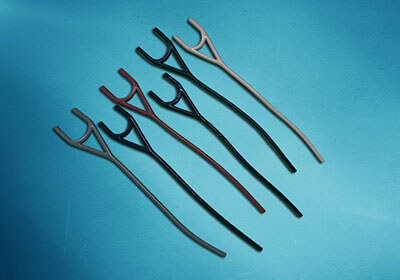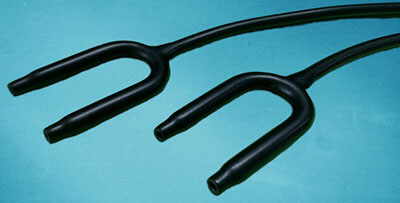With over 30 years experience, we mastered the crucial raw material ratio making the challenged dipping processing for tubing go successful.
Standard at 7mm Aperture, Dual Yoke with Dual Lumen

Standard at 5mm Aperture, Single Yoke with Single Lumen

We always adhere to our strict requirements which meet or exceed industry standards.
Contact us for an inquiry to see our efforts in this fields.
Polyvinyl Chloride
Y-tubing / A-tubing / Dual-tubing
Be specified to Panton
Glossy / Matte / Paint
Preheat the mandrel metal tool at around 300 degrees.
Dipping the mandrel into the liquid polymer. Eventually, the plastisol will begin to thicken into polyvinyl chloride around the mandrel. When the desired level of thickness is achieved, remove it from the plastisol.
Heating it again to allow the plastisol to fully fuse into a solid piece of polyvinyl chloride.
After it cools down, remove the tubing from the mandrel and the process is complete.
Most dip molding processes are performed using plastisol. A type of plastic consisting of PVC particles suspended in plasticizer, it's inexpensive and easy to use.
While manufacturers typically perform dip molding to create hollow plastic products or parts, some use this process to add a layer of plastic over a metal product or part. This process is known as plastic dip coating, and it differs from conventional dip molding by eliminating the need for a mandrel mold. With plastic dip molding, a metal product or part is submerged in a stainless tank of liquefied plastic which so called plastisol, typically at room temperature.
Plastisol dip molding is a process where a dipping mandrel is dipped into a liquid polymer, typically plastisol, to eventually create a solid form on the mandrel's external surface and allowing it to cool.Once cooled, the hardened plastic exterior is separated from the mold. Because the mold fills the space inside the plastic, dip molding creates products or parts with a hollow interior.Most molds are very simple and inexpensive.
Plastisol is a solution of powdered polyvinyl chloride (PVC) and plasticize. The metal mold is preheated to 350 degrees F. It is then dipped into plastisol.
The heat from the metal mold moves into the plastisol heating and swelling the PVC particles.The heated PVC particles swell, absorb the plasticizer, and then come in contact with each other.

The thickness of the coating is determined by the amount of time the metal mold stays in contact with the liquid plastisol. Then reheated to 350 degrees F. The reheating fuses the PVC particles together and forces off any excess plasticizer converting the remaining plastisol into an homogenous mass.